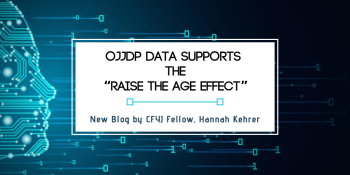OJJDP Data Supports the “Raise the Age Effect”

At the beginning of the year, the Office of Juvenile Justice and Delinquency Prevention (OJJDP) released multiple new data reports; one specifically highlighting the “Arrest Characteristics of Older Juveniles and Young Adults.” These data points show that since 2008, arrest rates have declined 60% for ages 15–17, 50% for ages 18–20, and 31% for ages 21–24. As states have “Raised the Age” of criminal responsibility to 18 or higher, the arrest rates of 18-20 year olds is also falling faster than other age groups in the adult systems.
Former Governor of Connecticut, Dannel Malloy, refers to this trend as the “Raise the Age Effect.” This essentially means that future adult crime is reduced because of the better outcomes 16 & 17 year olds experience under the age appropriate juvenile justice system, compared to their outcomes in the adult system. Connecticut was one of the first states to “Raise the Age” to 18 in 2007. This led to the removal of youth from the adult system, along with moving towards more developmentally appropriate juvenile justice approaches, including investments in community based alternatives to secure care. Data from OJJDP supports the claim that having youth under juvenile jurisdiction reduces the arrest rates of 18-20 year olds by 50%. Additional research by the Policy Justice Institute illustrates that when youth avoid the adult justice system they are less likely to reoffend.
The “Raise the Age Effect” allows communities a safer approach by keeping youth out of the adult system. According to the National Center for Juvenile Justice, the number of youth charged as adults has dropped from 175,000 youth per year (in 2007) to under 76,000 in 2015, and more youth being returned under the jurisdiction of juvenile court, juvenile arrests are continuing to fall across the board--including for crimes of violence. These improvements resulting from the “Raise the Age Effect” have led some states to propose raising the age of criminal responsibility from age 18 to 21. Vermont was the first state to raise the age beyond age 18, to include youth up to age 20. Connecticut, Illinois, and Massachusetts are among those who are working to raise the age beyond age 18. These three states all have raised their age of criminal responsibility to age 18 in the past decade, and have shown outcomes so positive that they are considering raising the age once more. This year, Colorado and Arizona are also exploring extending juvenile jurisdiction beyond age 18.
The “Raise the Age Effect” works because the juvenile justice system allows youth to receive better education, rehabilitation, and reentry options than they would have access to in the adult system. Treating juveniles in such an age appropriate manner is paramount to their healthy development and is a core principle of the juvenile justice system. Youth’s cognitive skills are still developing, leaving their behavior generally impulsive and with the lack of ability to focus or understand the consequences of their behavior. As a result, data tells us that when youth are returned to or are originally retained in the juvenile justice system, arrest rates for youth 18-20 drop.
Overall, treating youth as juveniles is beneficial for everyone. By raising the age, states are able to support young people in developmentally appropriate and fair ways that are backed by data. Which is why, juveniles should not be treated as adults in the justice system.

